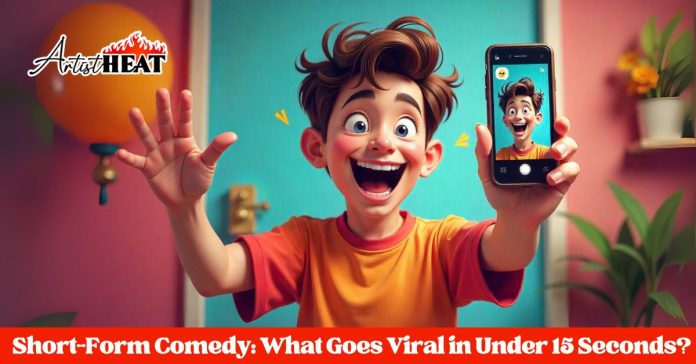The algorithm doesn’t care if you spent three weeks perfecting your comedy sketch. If it doesn’t hook viewers in the first three seconds, it’s digital roadkill. Welcome to the brutal world of short-form comedy, where attention spans are shorter than a TikTok dance trend and going viral depends on nailing the perfect punchline before someone scrolls away.
In 2025, we’re living in an era where short-form comedy has become the dominant entertainment format, with platforms like TikTok, Instagram Reels, and YouTube Shorts driving billions of views daily. However, the kicker is that being funny does not always work anymore in the so short-term as 15 seconds, so as to achieve a viral content. It is now a science, an art and quite frankly some sort of experiment on the human attention span.
The Science Behind Micro-Comedy Success
Short-form comedy operates on what psychologists call the “dopamine hit theory.” Your brain wants that little shot of endorphins and platforms have programmed their AI to make it happen even quicker than a pizza delivery man who respects his work.
And the magic number is not 15 seconds, as most people think, it is more like 3-5 seconds of hook, and quick-fire of delivery with the aim to make the viewer stick till the very last twist of the film. Among the creators such as Khaby Lame, this formula has been perfected at its most basic level, making comedy about relatability, timing, and visual storytelling that cuts across languages.
Platform-Specific Viral Formulas
Each platform has its own DNA when it comes to short-form comedy that goes viral. Tik Tok exists to incentivize being yourself and utilizing what sounds are popular, whereas Instagram Reels lends itself to more heavily edited videos with sharp edits. The newest competitor is YouTube Shorts, and it apparently prefers to prioritize content that resembles tiny YouTube clips instead of genuine social media content.
These nuances are realized by the creators who are crushing it at the moment. Look at an individual, such as Drew Gooden, who translates a more long-form, YouTube based approach to comedy into short enough segments to be cross platform and keeps his recognizable point of view. In the meantime, creators such as Brittany Broski have established empires based on the mastery of the reactionary comedy style that appears random yet is strategically prepared.
The Psychology of Instant Gratification
We’ve trained our brains to expect entertainment delivered at warp speed. Short-form comedy succeeds because it mirrors how we actually consume information in 2025 – frantically, impatiently, and with the constant threat of moving on to something else.
What many viral comedy video producers have learned, and, in my opinion, do best, is what I call the scroll-stopper formula: a surprise image, a familiar situation, and a joke that comes before you can figure out what happened. It is a kind of comedy specialized to appeal to such short-attention-span beings as goldfish, and it works better than conventional joke patterns ever did.
Timing Is Everything (Literally)
In short-form comedy, timing isn’t just about comedic beats – it is about the algorithms on the platforms, the publishing time, and surfing the waves. The artists who always gain a viral response have discovered that there is a probability of gaining a million views on social media when they publish relevant content during the times of highest activity but also adding popular music or hashtag to attract attention.
However this is where we get slippery. The joke that seems to fail at 2 PM may become a success at 8 PM not because it has become funnier but because the algorithm chose this moment to endow this joke with the opportunity to be seen. It sounds like the comedy roulette where you are the one to lose since the stage is always the house, but as an algorithmic face devoid of a human face, it may change its mind as frequently as an adolescent who cannot pick a show on Netflix.
The Dark Side of Micro-Entertainment
Let’s be real about something the platforms don’t want you to think about: short-form comedy is rewiring our brains in ways we’re only beginning to understand. We are making a generation that believes 30 seconds of video to be too long and that anything that takes longer concentration span is some old fashioned form of entertainment.
Producers are becoming exhausted quicker than ever before, caught in some kind of vicious circle in which they need to exceed their previous viral success. The need to continuously churn out content that reaches the mark in less than 15 seconds is causing the comedy world to obsess with quantity over quality, and the mental health of the creators that make the end product.
What Actually Makes Content Stick
The short-form comedy that truly goes viral in 2025 shares certain characteristics that transcend platform-specific tricks. It is relatable at first glance the kind of one that makes the audience say to themselves this is me literally. Second, it is eye catchy yet not tacky. Third, it has the rewatchability factor something that makes people share it or watch it more than once.
This was perfected by creators such as Caleb Hearon and Megan Stalter by developing characters and situations that are outlandish yet somehow culturally familiar. They are effective in their content since they touch on similar experiences but in a new light of comedy that hits every time.
The Future of Quick Laughs
Looking ahead, short-form comedy is evolving beyond simple joke delivery. We have interactive comedy and AR-friendly humor and AI-aided content generation that are beginning to build some overlap and fuzziness between the human aspect of creativity and machine efficiency.
Those who will succeed in the industry in the next few years are the creators who have both algorithmic knowledge and real creativity. They are not doing content-to-platforms but rather cultural moments that are luckily 15-seconds long.
The platforms themselves are also encouraging even briefer content, with some experimenting to 5 second maximum copy. It’s a race to the bottom of human attention spans, and short-form comedy is leading the charge with a smile and a perfectly timed punchline.
The truth is, short-form comedy isn’t just entertainment anymore – it has turned out to be a manifestation of the way we process information, how we form relationships and discover pleasure in a more and more atomized digital world. Is that an improvement or an indication of a post-culture? It would vary depending on between whether your last video made it to a million views or was left in the nether-land of algorithms.
And the next time you see a 10 second video of a person over-acting and responding to normal events that causes you to laugh remember you are not just a content consumer you are a part of largest attention span reducing experiment ever undertaken in the human history. And actually it is quite funny, you know.

